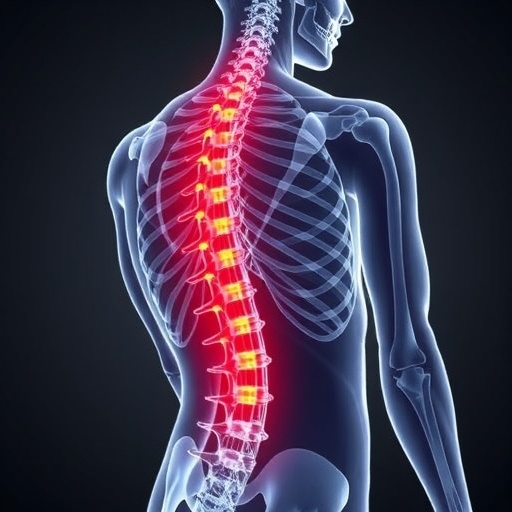Recent advancements in spinal biomechanics research are paving the way for more effective assessments of spinal health and function. A team of researchers led by Erb, F.A., Studer, D., and Büchler, P., has highlighted the necessity of adopting a systematic intervertebral motion parametrization. Their groundbreaking study, published in 2025 in the journal Annals of Biomedical Engineering, sheds light on how understanding motion parameters can significantly influence both clinical practices and biomechanical simulations. This research addresses a long-standing issue in orthopedic and rehabilitation sciences, providing new insights that could transform how spinal disorders are diagnosed and treated.
The spine’s complex structure and the intricate mechanics of intervertebral motion present unique challenges for clinicians and biomechanical engineers. For decades, researchers have grappled with how best to quantify the dynamic movements of the vertebrae during different physical activities. The lack of a standardized method for evaluating intervertebral motion has hindered advancements in personalized medicine and rehabilitation strategies. This study aims to fill that gap by proposing a systematic approach to assess biomechanical parameters in vivo, establishing a new standard for future research.
In their methodology, the authors employed advanced imaging techniques alongside motion capture technology to create a comprehensive framework for understanding spine biomechanics. This blending of technologies allows for a high-fidelity analysis of how individual vertebrae interact with one another during various loads and movements. The researchers believe that by quantifying these interactions meticulously, it becomes possible to predict potential points of injury or failure within the spinal column, thereby steering clinical intervention strategies.
One of the significant benefits of this research lies in its potential applicability across a wide range of conditions. From chronic back pain to post-surgical assessments, understanding intervertebral dynamics is crucial in formulating individualized treatment plans. By systematically isolating and analyzing parameters such as rotation, translation, and shear forces between vertebrae, clinicians can tailor rehabilitation programs based on an individual’s specific biomechanical profile. This personalized approach signifies a paradigm shift in the treatment of spinal disorders.
Moreover, the implications extend beyond just clinical applications. The systematic parametrization of intervertebral motion also holds tremendous value for biomechanical researchers engaged in theoretical models and simulations. The research conducted by Erb and colleagues provides a foundational framework that can enhance the predictive accuracy of computational models, thereby improving their efficacy in virtual surgery simulations and other applications. Researchers aiming to simulate surgical outcomes or to develop new surgical instruments can greatly benefit from applying these insights.
Another noteworthy aspect of the study is its multi-disciplinary nature. The collaborative efforts of engineers, orthopedic surgeons, and computational scientists underline the importance of cross-disciplinary research in addressing complex health issues. The combination of clinical insight and engineering prowess helps formulate a more robust understanding of spine biomechanics, driving innovation in treatment methodologies and technologies.
As spinal health becomes an increasingly pressing concern in our aging population, this study could not have come at a better time. Spine-related disorders frequently lead to significant morbidity and healthcare costs. By offering a systematic method to evaluate spinal biomechanics, this research not only enhances our understanding but also opens avenues for improving patient outcomes and quality of life. The potential for early identification of at-risk patients could lead to timely interventions, reducing the burden of chronic back pain and its associated complications.
The researchers underscore the importance of continued exploration in this field, urging the need for further investigations that build upon their foundational work. They aim to refine their techniques and broaden their applicability, envisioning a future where such systematic assessments become a routine part of orthopedic evaluations. This future-oriented mindset is crucial as the medical community strives to keep pace with emerging technologies and patient care paradigms.
While this study sets a solid groundwork, it also raises several questions about the long-term impacts of systematic intervertebral motion parametrization in real-world settings. The necessity for large-scale clinical trials to validate the parameters identified cannot be understated, as real-world application will ultimately dictate clinical relevance. The researchers plan to engage in further studies, collaborating with clinical partners to explore the translatability of their findings into everyday medical practice.
A key takeaway from the study is the emphasis on the intricacies of spine health that have been previously underrecognized. By shifting the focus to intervertebral dynamics, the authors encourage a reassessment of how spine issues are categorized and treated. This new angle offers a fresh perspective on various spinal disorders, including disc herniation, scoliosis, and post-surgical changes, meriting further inquiry into their biomechanical underpinnings.
The urgency of addressing the intricacies of spine biomechanics aligns with the broader movement towards personalized medicine, where treatments are tailored to individual patient profiles. The ability to predict and enhance functional outcomes based on specific biomechanical metrics will serve as a cornerstone of future orthopedic innovation. As such, this study not only contributes to academic literature but also catalyzes a much-needed conversation about best practices in spinal care.
In conclusion, the research led by Erb, Studer, and Büchler represents a significant advancement in the field of spine biomechanics. By establishing a systematic approach to intervertebral motion parametrization, the authors illuminate the path to improved clinical assessments and personalized treatment protocols. As the medical community moves towards increasingly sophisticated methods of evaluation, this study provides a timely reminder of the importance of adapting our methodologies to ensure optimal patient care and outcomes.
As the findings filter through to clinical practice, the hope is that a collective shift towards systematic parametric evaluations will inspire similar approaches in other areas of biomedical engineering. The potential to improve patient lives through rigorous scientific inquiry and collaboration is an exciting prospect that everyone in the field should embrace.
Subject of Research: Spine Biomechanics and Intervertebral Motion
Article Title: Importance of a Systematic Intervertebral Motion Parametrization for in vivo Assessment of Spine Biomechanics
Article References:
Erb, F.A., Studer, D., Büchler, P. et al. Importance of a Systematic Intervertebral Motion Parametrization for in vivo Assessment of Spine Biomechanics.
Ann Biomed Eng (2025). https://doi.org/10.1007/s10439-025-03885-x
Image Credits: AI Generated
DOI: https://doi.org/10.1007/s10439-025-03885-x
Keywords: Spine biomechanics, intervertebral motion, personalized medicine, clinical assessment, biomechanical modeling.
Tags: advanced imaging techniques in biomechanicsbiomechanical simulations in medicineclinical practices in spinal disordersdynamic movements of vertebraeintervertebral motion assessmentmotion capture technology for spine analysisorthopedic and rehabilitation sciencespersonalized medicine in spine treatmentspinal biomechanics researchspine health and functionsystematic motion parametrizationtransformative insights in spinal health





